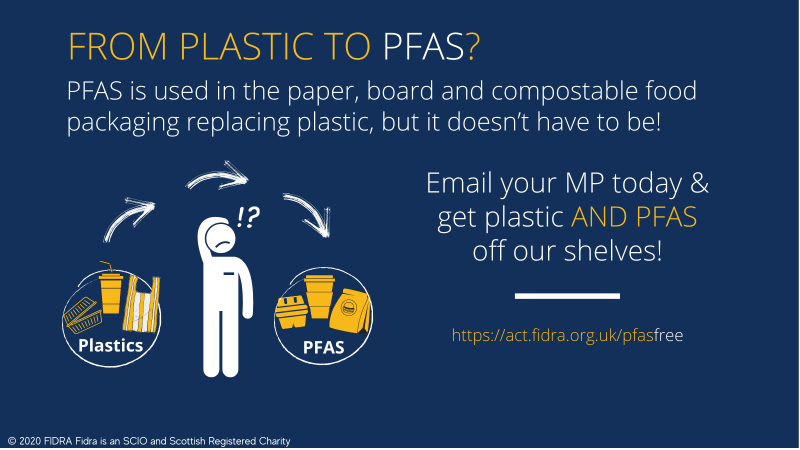As we strive to reduce single-use plastic, are we simply swapping one visible pollutant for a more toxic and persistent chemical alternative?
PFAS are widely used in the manufacture of paper, board and compostable food packaging. They are also polluting our environment, accumulating in our wildlife and contaminating the food that we eat. But this can change! The EU has recently committed to ban all non-essential uses of PFAS, and we want the UK Government to do the same. Today we’re launching our new initiative, asking the UK public to email their MP and take action on PFAS. Will you join us?
The problem with PFAS
PFAS (per- and poly- fluorinated alkyl substances) are a group of over 4,700 industrial chemicals, widely used in the paper, board and compostable food packaging that is rapidly replacing plastic across the UK. Known as ‘Forever Chemicals’ because they don’t break down in the environment, PFAS are a problem we can no longer afford to ignore.
These chemicals are polluting our rivers, accumulating in wildlife and contaminating the food that we eat. With a growing list of health impacts, including evidence that links exposure to reduced vaccine efficacy, this is a risk too great to accept.
The solution
Denmark has already implemented a ban on the addition of PFAS to food packaging. The EU has already committed to banning PFAS from all non-essenital uses. UK supermarkets are already taking voluntary action, looking at uses within their own supply chains and even committing to phasing PFAS out of their food packaging completely. Suppliers are getting their products tested and developing innovative and genuinely sustainable alternatives.
Plastic-free, PFAS-free food packaging is already on the market, we do not need to accept this growing source of unnecessary pollution.
But, voluntary action is not enough. To genuinely protect our health and the environment, we need the UK Government to act now, follow the Danish example, and ban all PFAS from food packaging. As we move away from single-use plastic, we must ensure we do not simply swap one harmful pollutant for another.
With the UK chemicals strategy currently in development, we also have an important opportunity to secure a longer-term commitment to phase-out all non-essential uses of PFAS, ensuring these chemicals no longer pose a threat to our health and our environment.
Write to your MP
Will you help us? Email your MP today and ask them to urge the government to take tougher action on PFAS!
We’ve already set up draft emails, tailored to your local MP and ready for you to send, so please, click below, and in only a few minutes you can have your say, and help us stop this harmful and unnecessary source of chemical pollution.


